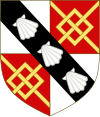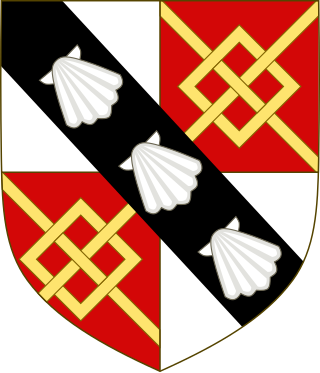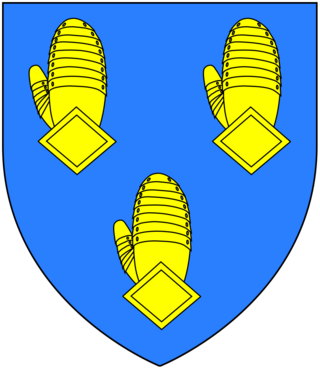Noteworthy Despenser and Spencer families
Robert Despenser
Robert d'Abbetot [nb 1] was granted titles, lands and a high position in William's court. In addition to his position as steward, he also was given land grants in county Bedford. He held his office for the period c.1088–1098. [18]
In England, Robert was best known by his occupation, and hence became known as Robert le Despenser (many spelling variants of this name exist including Robert the Dispensor, Robert Despensator, [9] Robert Dispenser [19] ), which reflected his new official position, [20] of using a patronymic, as Robert fitzThurstin. [18] He seems to have maintained his favor with William because in the Domesday Book of 1086, Robert Despenser was listed as a land tenant-in-chief in Gloucestershire, Leicestershire, Lincolnshire, Oxfordshire, and Warwickshire, as well as holding lands in Worcestershire obtained from the Bishop of Worcester. [18]
Robert is assumed to have died shortly after restoring some estates to Westminster Abbey [18] but he appears to have had no legitimate male children, as his heir was his brother Urse d'Abetot. [21] He may have had a daughter, as some of his lands were inherited by the Marmion family, but it is also possible that a daughter of Urse married into the Marmion family. [20] Robert's office as the king's steward may also have gone to Urse, as it was later held by Urse's heirs. Subsequent bearers of the Despenser or Spencer surname would not descend from Robert.
King's Dispensers
The steward of William II of England was Thurstan, Dispensator Regis (royal steward). His son Hugh was Dispensator Regis in 1105 under Henry I, and was followed by his son or brother, Simon, Dispensator Regis for Henry and Stephen. Simon was father of a second Thurstan, who was active in the 1250s under Henry II, to be followed by his son Walter as Dispensator Regis. Walter was succeeded by his brother Aymer, Dispensator Regis under king John, and Aymer's son Thurstan le Despenser, who served under Henry III, dying in 1249. He was followed by a son, Adam le Despenser, who was summoned by Edward I of England to perform military service and in 1283 to attend on the king in what was a precursor to the first royally-convened Parliament. His heir was a son, Aymer le Despenser, but he alienated his lands and titles during the reign of Edward II. [22] [23] [24]
Lords Despencer

In the early 13th century, a family that had been stewards to the Earls of Chester rose to prominence. [25] Hugh le Despenser (died 1238) became High Sheriff of Berkshire, and his son, Hugh became Justiciar of England and was summoned in 1264 to the Parliament of Simon de Montfort as Lord Despencer. His son also named Hugh was created Earl of Winchester, while a descendant was made Earl of Gloucester. The family experienced a number of attainders, restorations, and creations of new lordships over the 13th and 14th centuries, with a claim to the last creation passing by marriage to the Wentworth family in the 15th century. The initial establishment was brought out of abeyance in favour of a female-line descendant in 1604, from which time the title of Baron le Despencer has descended to the current Viscount Falmouth.
Spencer aristocracy

The English aristocratic Spencer family has resided at their ancestral home at Althorp, Northamptonshire, since the early 16th century. The Estate now covers 14,000 acres (57 km2) in Northamptonshire, Warwickshire and Norfolk. From pre-Tudor times the Spencers had been farmers, coming to prominence in Warwickshire in the 15th century when John Spencer became feoffee of Wormleighton in 1469, and a tenant at Althorp in 1486. His nephew, another John, used the gains from trade in livestock and commodities to buy both properties. He was knighted in 1504 and died in 1522. John's descendants expanded the family holdings through business dealings and marriage into the peerage. The family is related through marriage to the Churchills of Blenheim Palace, a line that included the Dukes of Marlborough and Winston Churchill. From the Althorp line came the Earls of Sunderland, the later Dukes of Marlborough, and the Earls Spencer. The family captured international attention when Lady Diana Frances Spencer married Prince Charles on 29 July 1981, until her death in a car crash in Paris on 31 August 1997. [26]
Heraldry
The varied origins of people with the Spencer and Despenser surnames means that they are not all members of the same family, and each individual family would have distinct coats of arms, while most Spencers are not entitled to bear any arms. The family of the King's Dispensers bore an ermine shield with chief of unknown tincture. [22] The Lords Despencer bore arms from the early days of heraldry, which are one of a family of quarterly arms seen among the vassals of the Earls of Chester. Scholars have suggested a possible derivation from those of the Dutton family, [27] or from the family of their one-time feudal overlords, Beauchamp of Bedford, whose own arms belonged to a shared group of similar bearings among Mandeville and Vere family vassals and descendants. [28] They are described in the language of heraldry as quarterly: 1st & 4th, Argent; 2nd & 3rd, Gules a fret or, over all a bend sable. In 1504, John Spencer of Althorp was granted for himself and his brother the arms: azure, a fess ermine between six sea-mews' heads erased argent, and in 1564 a descendant of his uncle was granted: sable, on a fess or, between 3 bezants, as many lions heads of the first. As the end of the century approached, however, the family's growing social status would lead them to adopt a forged pedigree that gave them an ancient derivation, and they began using new arms that represented a claimed kinship with the (actually entirely unrelated) Lords Despencer, modifying the earlier family's quarterly arms by the addition of three escallops (scallop shells). [29] Numerous variations of this differenced coat, along with various Spencer arms bearing no resemblance to those of the Lords le Despenser, have been catalogued. [30]









